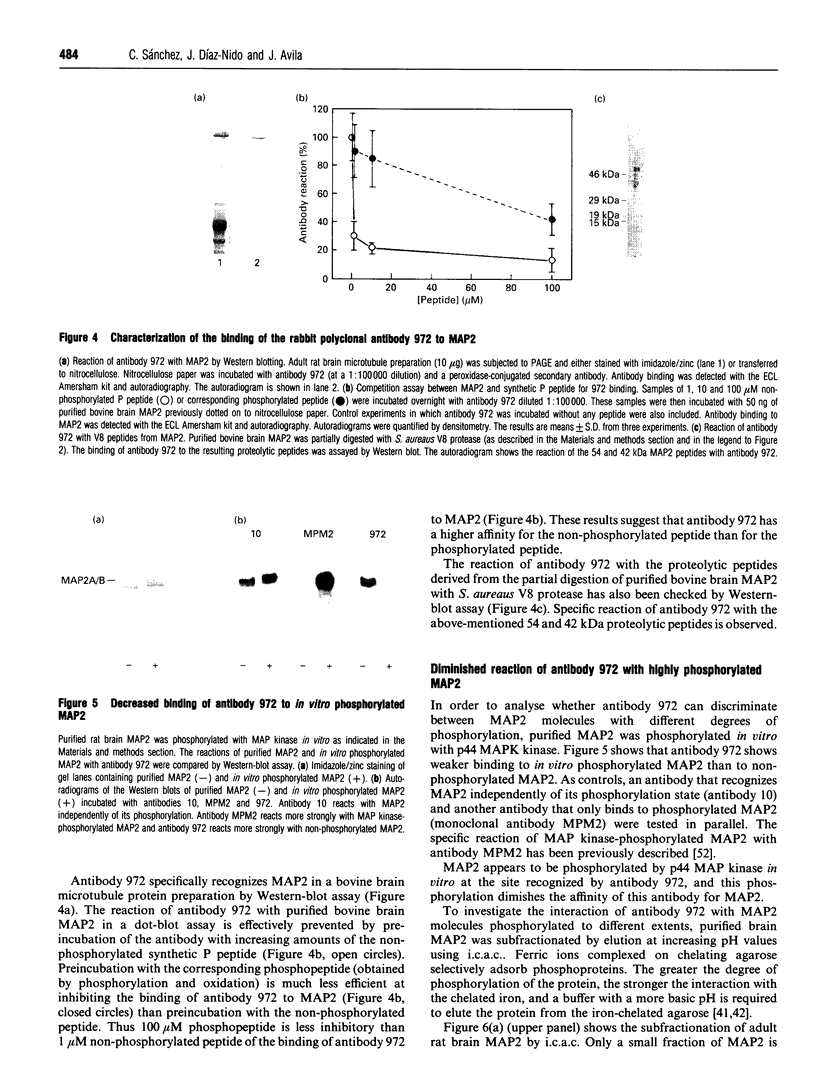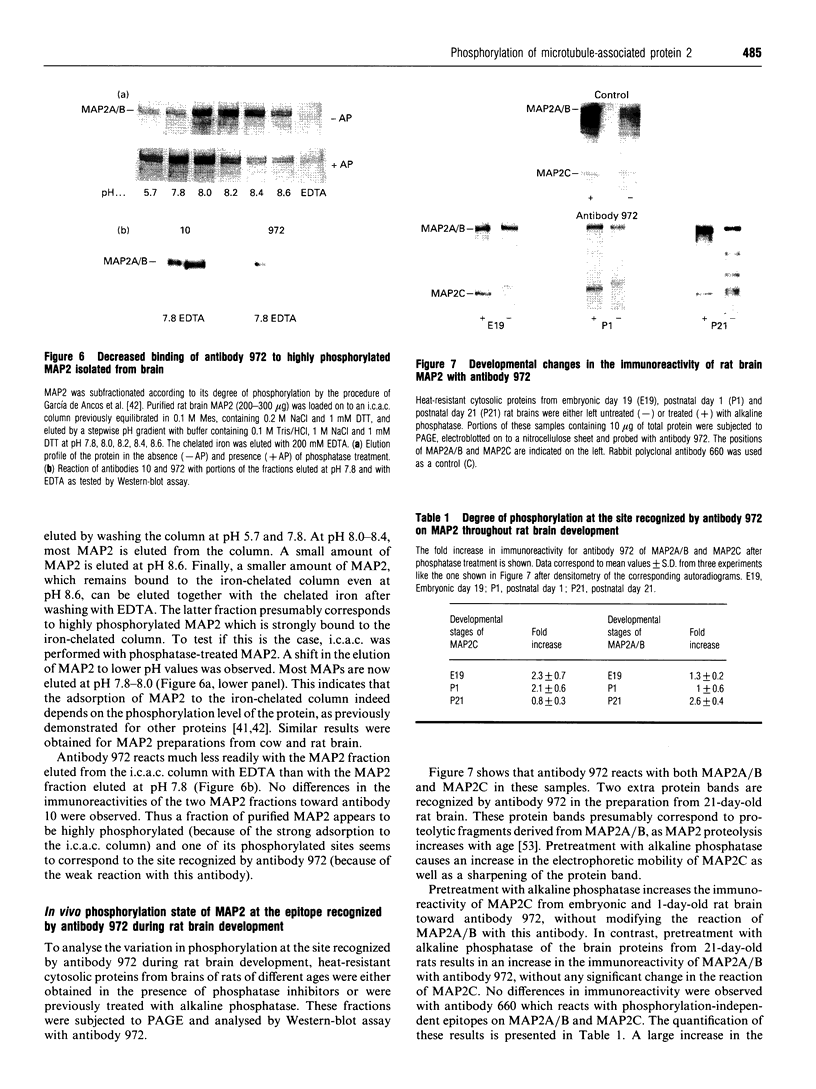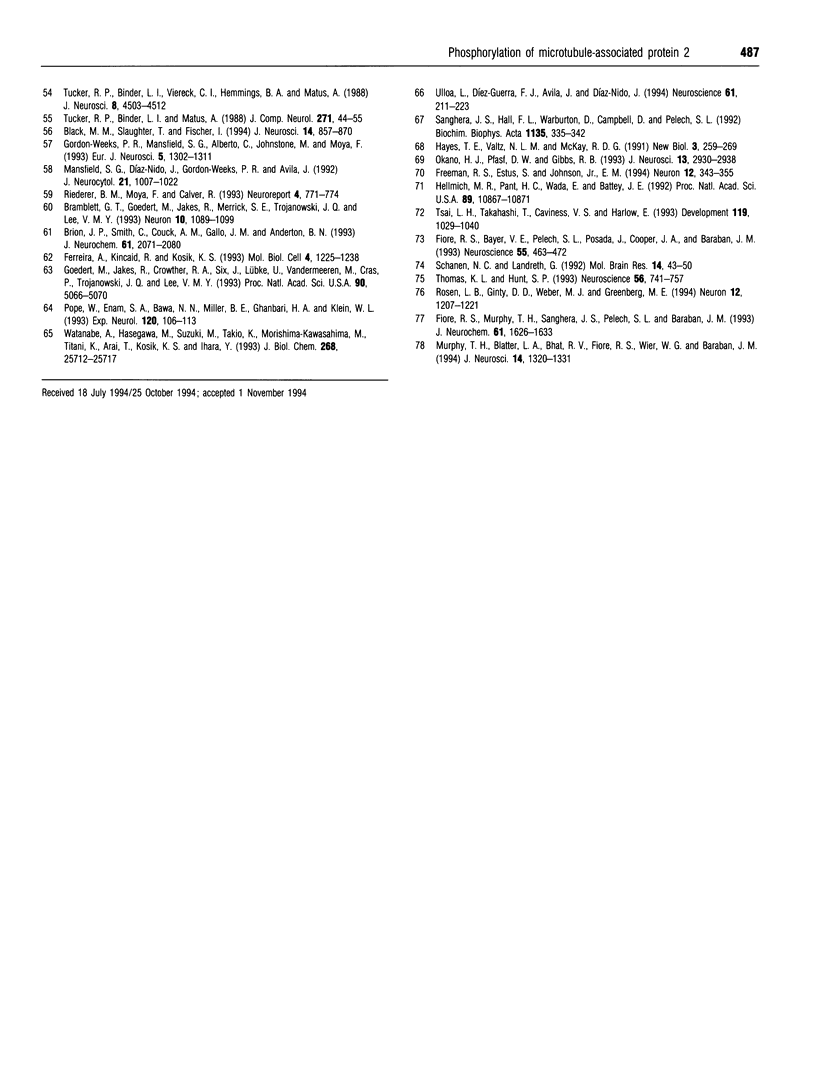Abstract
Microtubule-associated protein 2 (MAP2) is an in vitro substrate for MAP kinase. Part of the phosphorylation occurs at the C-terminal microtubule-binding domain of the molecule which contains a cluster of putative consensus sites for MAP kinase on a proline-rich region. A peptide with the sequence RTPGTPG-TPSY, located at this region of the molecule, is efficiently phosphorylated by MAP kinase in vitro. An antibody (972) raised against this non-phosphorylated peptide has been used to test for in vivo phosphorylation at the proline-rich domain of the MAP2 molecule. The reaction of purified MAP2 with antibody 972 diminishes after in vitro phosphorylation by MAP kinase and is enhanced after in vitro dephosphorylation by alkaline phosphatase. A fraction of brain MAP2 isolated by iron-chelation affinity chromatography appears to be phosphorylated in vivo at the site recognized by antibody 972. There is some variation in the phosphorylation of MAP2 at the proline-rich region throughout rat brain development. MAP2C is more highly phosphorylated in the developing rat brain, whereas high-molecular-mass MAP2 is more extensively phosphorylated in the adult rat brain.
Full text
PDF






Images in this article
Selected References
These references are in PubMed. This may not be the complete list of references from this article.
- Andrews D. M., Kitchin J., Seale P. W. Solid-phase synthesis of a range of O-phosphorylated peptides by post-assembly phosphitylation and oxidation. Int J Pept Protein Res. 1991 Nov;38(5):469–475. doi: 10.1111/j.1399-3011.1991.tb01528.x. [DOI] [PubMed] [Google Scholar]
- Aoki C., Siekevitz P. Ontogenetic changes in the cyclic adenosine 3',5'-monophosphate-stimulatable phosphorylation of cat visual cortex proteins, particularly of microtubule-associated protein 2 (MAP 2): effects of normal and dark rearing and of the exposure to light. J Neurosci. 1985 Sep;5(9):2465–2483. doi: 10.1523/JNEUROSCI.05-09-02465.1985. [DOI] [PMC free article] [PubMed] [Google Scholar]
- Barro O., Joly C., Condamine H., Boulekbache H. Widespread expression of the Xenopus homeobox gene Xhox3 in zebrafish eggs causes a disruption of the anterior-posterior axis. Int J Dev Biol. 1994 Dec;38(4):613–622. [PubMed] [Google Scholar]
- Black M. M., Slaughter T., Fischer I. Microtubule-associated protein 1b (MAP1b) is concentrated in the distal region of growing axons. J Neurosci. 1994 Feb;14(2):857–870. doi: 10.1523/JNEUROSCI.14-02-00857.1994. [DOI] [PMC free article] [PubMed] [Google Scholar]
- Bramblett G. T., Goedert M., Jakes R., Merrick S. E., Trojanowski J. Q., Lee V. M. Abnormal tau phosphorylation at Ser396 in Alzheimer's disease recapitulates development and contributes to reduced microtubule binding. Neuron. 1993 Jun;10(6):1089–1099. doi: 10.1016/0896-6273(93)90057-x. [DOI] [PubMed] [Google Scholar]
- Brion J. P., Smith C., Couck A. M., Gallo J. M., Anderton B. H. Developmental changes in tau phosphorylation: fetal tau is transiently phosphorylated in a manner similar to paired helical filament-tau characteristic of Alzheimer's disease. J Neurochem. 1993 Dec;61(6):2071–2080. doi: 10.1111/j.1471-4159.1993.tb07444.x. [DOI] [PubMed] [Google Scholar]
- Brugg B., Matus A. Phosphorylation determines the binding of microtubule-associated protein 2 (MAP2) to microtubules in living cells. J Cell Biol. 1991 Aug;114(4):735–743. doi: 10.1083/jcb.114.4.735. [DOI] [PMC free article] [PubMed] [Google Scholar]
- Burns R. G., Islam K., Chapman R. The multiple phosphorylation of the microtubule-associated protein MAP2 controls the MAP2:tubulin interaction. Eur J Biochem. 1984 Jun 15;141(3):609–615. doi: 10.1111/j.1432-1033.1984.tb08236.x. [DOI] [PubMed] [Google Scholar]
- Caceres A., Banker G., Steward O., Binder L., Payne M. MAP2 is localized to the dendrites of hippocampal neurons which develop in culture. Brain Res. 1984 Apr;315(2):314–318. doi: 10.1016/0165-3806(84)90167-6. [DOI] [PubMed] [Google Scholar]
- Caceres A., Payne M. R., Binder L. I., Steward O. Immunocytochemical localization of actin and microtubule-associated protein MAP2 in dendritic spines. Proc Natl Acad Sci U S A. 1983 Mar;80(6):1738–1742. doi: 10.1073/pnas.80.6.1738. [DOI] [PMC free article] [PubMed] [Google Scholar]
- Clark-Lewis I., Sanghera J. S., Pelech S. L. Definition of a consensus sequence for peptide substrate recognition by p44mpk, the meiosis-activated myelin basic protein kinase. J Biol Chem. 1991 Aug 15;266(23):15180–15184. [PubMed] [Google Scholar]
- Czernik A. J., Girault J. A., Nairn A. C., Chen J., Snyder G., Kebabian J., Greengard P. Production of phosphorylation state-specific antibodies. Methods Enzymol. 1991;201:264–283. doi: 10.1016/0076-6879(91)01025-w. [DOI] [PubMed] [Google Scholar]
- Davis R. J. The mitogen-activated protein kinase signal transduction pathway. J Biol Chem. 1993 Jul 15;268(20):14553–14556. [PubMed] [Google Scholar]
- De Camilli P., Miller P. E., Navone F., Theurkauf W. E., Vallee R. B. Distribution of microtubule-associated protein 2 in the nervous system of the rat studied by immunofluorescence. Neuroscience. 1984 Apr;11(4):817–846. [PubMed] [Google Scholar]
- Doll T., Meichsner M., Riederer B. M., Honegger P., Matus A. An isoform of microtubule-associated protein 2 (MAP2) containing four repeats of the tubulin-binding motif. J Cell Sci. 1993 Oct;106(Pt 2):633–639. doi: 10.1242/jcs.106.2.633. [DOI] [PubMed] [Google Scholar]
- Díaz-Nido J., Montoro R. J., López-Barneo J., Avila J. High external potassium induces an increase in the phosphorylation of the cytoskeletal protein MAP2 in rat hippocampal slices. Eur J Neurosci. 1993 Jul 1;5(7):818–824. doi: 10.1111/j.1460-9568.1993.tb00933.x. [DOI] [PubMed] [Google Scholar]
- Díaz-Nido J., Serrano L., Hernández M. A., Avila J. Phosphorylation of microtubule proteins in rat brain at different developmental stages: comparison with that found in neuronal cultures. J Neurochem. 1990 Jan;54(1):211–222. doi: 10.1111/j.1471-4159.1990.tb13303.x. [DOI] [PubMed] [Google Scholar]
- Fernandez-Patron C., Castellanos-Serra L., Rodriguez P. Reverse staining of sodium dodecyl sulfate polyacrylamide gels by imidazole-zinc salts: sensitive detection of unmodified proteins. Biotechniques. 1992 Apr;12(4):564–573. [PubMed] [Google Scholar]
- Ferreira A., Kincaid R., Kosik K. S. Calcineurin is associated with the cytoskeleton of cultured neurons and has a role in the acquisition of polarity. Mol Biol Cell. 1993 Dec;4(12):1225–1238. doi: 10.1091/mbc.4.12.1225. [DOI] [PMC free article] [PubMed] [Google Scholar]
- Fiore R. S., Bayer V. E., Pelech S. L., Posada J., Cooper J. A., Baraban J. M. p42 mitogen-activated protein kinase in brain: prominent localization in neuronal cell bodies and dendrites. Neuroscience. 1993 Jul;55(2):463–472. doi: 10.1016/0306-4522(93)90516-i. [DOI] [PubMed] [Google Scholar]
- Fiore R. S., Murphy T. H., Sanghera J. S., Pelech S. L., Baraban J. M. Activation of p42 mitogen-activated protein kinase by glutamate receptor stimulation in rat primary cortical cultures. J Neurochem. 1993 Nov;61(5):1626–1633. doi: 10.1111/j.1471-4159.1993.tb09796.x. [DOI] [PubMed] [Google Scholar]
- Freeman R. S., Estus S., Johnson E. M., Jr Analysis of cell cycle-related gene expression in postmitotic neurons: selective induction of Cyclin D1 during programmed cell death. Neuron. 1994 Feb;12(2):343–355. doi: 10.1016/0896-6273(94)90276-3. [DOI] [PubMed] [Google Scholar]
- García de Ancos J., Correas I., Avila J. Differences in microtubule binding and self-association abilities of bovine brain tau isoforms. J Biol Chem. 1993 Apr 15;268(11):7976–7982. [PubMed] [Google Scholar]
- Garner C. C., Matus A. Different forms of microtubule-associated protein 2 are encoded by separate mRNA transcripts. J Cell Biol. 1988 Mar;106(3):779–783. doi: 10.1083/jcb.106.3.779. [DOI] [PMC free article] [PubMed] [Google Scholar]
- Goedert M., Jakes R., Crowther R. A., Six J., Lübke U., Vandermeeren M., Cras P., Trojanowski J. Q., Lee V. M. The abnormal phosphorylation of tau protein at Ser-202 in Alzheimer disease recapitulates phosphorylation during development. Proc Natl Acad Sci U S A. 1993 Jun 1;90(11):5066–5070. doi: 10.1073/pnas.90.11.5066. [DOI] [PMC free article] [PubMed] [Google Scholar]
- Gordon-Weeks P. R., Mansfield S. G., Alberto C., Johnstone M., Moya F. A phosphorylation epitope on MAP 1B that is transiently expressed in growing axons in the developing rat nervous system. Eur J Neurosci. 1993 Oct 1;5(10):1302–1311. doi: 10.1111/j.1460-9568.1993.tb00916.x. [DOI] [PubMed] [Google Scholar]
- Goto S., Yamamoto H., Fukunaga K., Iwasa T., Matsukado Y., Miyamoto E. Dephosphorylation of microtubule-associated protein 2, tau factor, and tubulin by calcineurin. J Neurochem. 1985 Jul;45(1):276–283. doi: 10.1111/j.1471-4159.1985.tb05504.x. [DOI] [PubMed] [Google Scholar]
- Halpain S., Greengard P. Activation of NMDA receptors induces rapid dephosphorylation of the cytoskeletal protein MAP2. Neuron. 1990 Sep;5(3):237–246. doi: 10.1016/0896-6273(90)90161-8. [DOI] [PubMed] [Google Scholar]
- Hayes T. E., Valtz N. L., McKay R. D. Downregulation of CDC2 upon terminal differentiation of neurons. New Biol. 1991 Mar;3(3):259–269. [PubMed] [Google Scholar]
- Hellmich M. R., Pant H. C., Wada E., Battey J. F. Neuronal cdc2-like kinase: a cdc2-related protein kinase with predominantly neuronal expression. Proc Natl Acad Sci U S A. 1992 Nov 15;89(22):10867–10871. doi: 10.1073/pnas.89.22.10867. [DOI] [PMC free article] [PubMed] [Google Scholar]
- Hernández M. A., Wandosell F., Avila J. Localization of the phosphorylation sites for different kinases in the microtubule-associated protein MAP2. J Neurochem. 1987 Jan;48(1):84–93. doi: 10.1111/j.1471-4159.1987.tb13130.x. [DOI] [PubMed] [Google Scholar]
- Herzog W., Weber K. Fractionation of brain microtubule-associated proteins. Isolation of two different proteins which stimulate tubulin polymerization in vitro. Eur J Biochem. 1978 Dec 1;92(1):1–8. doi: 10.1111/j.1432-1033.1978.tb12716.x. [DOI] [PubMed] [Google Scholar]
- Hoshi M., Ohta K., Gotoh Y., Mori A., Murofushi H., Sakai H., Nishida E. Mitogen-activated-protein-kinase-catalyzed phosphorylation of microtubule-associated proteins, microtubule-associated protein 2 and microtubule-associated protein 4, induces an alteration in their function. Eur J Biochem. 1992 Jan 15;203(1-2):43–52. doi: 10.1111/j.1432-1033.1992.tb19825.x. [DOI] [PubMed] [Google Scholar]
- Huber G., Matus A. Differences in the cellular distributions of two microtubule-associated proteins, MAP1 and MAP2, in rat brain. J Neurosci. 1984 Jan;4(1):151–160. doi: 10.1523/JNEUROSCI.04-01-00151.1984. [DOI] [PMC free article] [PubMed] [Google Scholar]
- Jameson L., Frey T., Zeeberg B., Dalldorf F., Caplow M. Inhibition of microtubule assembly by phosphorylation of microtubule-associated proteins. Biochemistry. 1980 May 27;19(11):2472–2479. doi: 10.1021/bi00552a027. [DOI] [PubMed] [Google Scholar]
- Johnson G. V., Jope R. S. The role of microtubule-associated protein 2 (MAP-2) in neuronal growth, plasticity, and degeneration. J Neurosci Res. 1992 Dec;33(4):505–512. doi: 10.1002/jnr.490330402. [DOI] [PubMed] [Google Scholar]
- Karr T. L., White H. D., Purich D. L. Characterization of brain microtubule proteins prepared by selective removal of mitochondrial and synaptosomal components. J Biol Chem. 1979 Jul 10;254(13):6107–6111. [PubMed] [Google Scholar]
- Kindler S., Schulz B., Goedert M., Garner C. C. Molecular structure of microtubule-associated protein 2b and 2c from rat brain. J Biol Chem. 1990 Nov 15;265(32):19679–19684. [PubMed] [Google Scholar]
- Kuang J., Ashorn C. L. At least two kinases phosphorylate the MPM-2 epitope during Xenopus oocyte maturation. J Cell Biol. 1993 Nov;123(4):859–868. doi: 10.1083/jcb.123.4.859. [DOI] [PMC free article] [PubMed] [Google Scholar]
- Laemmli U. K. Cleavage of structural proteins during the assembly of the head of bacteriophage T4. Nature. 1970 Aug 15;227(5259):680–685. doi: 10.1038/227680a0. [DOI] [PubMed] [Google Scholar]
- Ledesma M. D., Correas I., Avila J., Díaz-Nido J. Implication of brain cdc2 and MAP2 kinases in the phosphorylation of tau protein in Alzheimer's disease. FEBS Lett. 1992 Aug 17;308(2):218–224. doi: 10.1016/0014-5793(92)81278-t. [DOI] [PubMed] [Google Scholar]
- Lewis S. A., Wang D. H., Cowan N. J. Microtubule-associated protein MAP2 shares a microtubule binding motif with tau protein. Science. 1988 Nov 11;242(4880):936–939. doi: 10.1126/science.3142041. [DOI] [PubMed] [Google Scholar]
- Ludin B., Matus A. The neuronal cytoskeleton and its role in axonal and dendritic plasticity. Hippocampus. 1993;3(Spec No):61–71. [PubMed] [Google Scholar]
- Matus A., Green G. D. Age-related increase in a cathepsin D like protease that degrades brain microtubule-associated proteins. Biochemistry. 1987 Dec 15;26(25):8083–8086. doi: 10.1021/bi00399a010. [DOI] [PubMed] [Google Scholar]
- Montoro R. J., Díaz-Nido J., Avila J., López-Barneo J. N-methyl-D-aspartate stimulates the dephosphorylation of the microtubule-associated protein 2 and potentiates excitatory synaptic pathways in the rat hippocampus. Neuroscience. 1993 Jun;54(4):859–871. doi: 10.1016/0306-4522(93)90580-9. [DOI] [PubMed] [Google Scholar]
- Morales M., Fifkova E. Distribution of MAP2 in dendritic spines and its colocalization with actin. An immunogold electron-microscope study. Cell Tissue Res. 1989 Jun;256(3):447–456. doi: 10.1007/BF00225592. [DOI] [PubMed] [Google Scholar]
- Murphy T. H., Blatter L. A., Bhat R. V., Fiore R. S., Wier W. G., Baraban J. M. Differential regulation of calcium/calmodulin-dependent protein kinase II and p42 MAP kinase activity by synaptic transmission. J Neurosci. 1994 Mar;14(3 Pt 1):1320–1331. doi: 10.1523/JNEUROSCI.14-03-01320.1994. [DOI] [PMC free article] [PubMed] [Google Scholar]
- Murthy A. S., Flavin M. Microtubule assembly using the microtubule-associated protein MAP-2 prepared in defined states of phosphorylation with protein kinase and phosphatase. Eur J Biochem. 1983 Dec 1;137(1-2):37–46. doi: 10.1111/j.1432-1033.1983.tb07792.x. [DOI] [PubMed] [Google Scholar]
- Muszyńska G., Andersson L., Porath J. Selective adsorption of phosphoproteins on gel-immobilized ferric chelate. Biochemistry. 1986 Nov 4;25(22):6850–6853. doi: 10.1021/bi00370a018. [DOI] [PubMed] [Google Scholar]
- Okano H. J., Pfaff D. W., Gibbs R. B. RB and Cdc2 expression in brain: correlations with 3H-thymidine incorporation and neurogenesis. J Neurosci. 1993 Jul;13(7):2930–2938. doi: 10.1523/JNEUROSCI.13-07-02930.1993. [DOI] [PMC free article] [PubMed] [Google Scholar]
- Peter M., Sanghera J. S., Pelech S. L., Nigg E. A. Mitogen-activated protein kinases phosphorylate nuclear lamins and display sequence specificity overlapping that of mitotic protein kinase p34cdc2. Eur J Biochem. 1992 Apr 1;205(1):287–294. doi: 10.1111/j.1432-1033.1992.tb16779.x. [DOI] [PubMed] [Google Scholar]
- Pope W., Enam S. A., Bawa N., Miller B. E., Ghanbari H. A., Klein W. L. Phosphorylated tau epitope of Alzheimer's disease is coupled to axon development in the avian central nervous system. Exp Neurol. 1993 Mar;120(1):106–113. doi: 10.1006/exnr.1993.1044. [DOI] [PubMed] [Google Scholar]
- Riederer B. M., Moya F., Calvert R. Phosphorylated MAP1b, alias MAP5 and MAP1x, is involved in axonal growth and neuronal mitosis. Neuroreport. 1993 Jun;4(6):771–774. doi: 10.1097/00001756-199306000-00044. [DOI] [PubMed] [Google Scholar]
- Sanghera J. S., Hall F. L., Warburton D., Campbell D., Pelech S. L. Identification of epidermal growth factor Thr-669 phosphorylation site peptide kinases as distinct MAP kinases and p34cdc2. Biochim Biophys Acta. 1992 Jun 29;1135(3):335–342. doi: 10.1016/0167-4889(92)90240-c. [DOI] [PubMed] [Google Scholar]
- Sattilaro R. F. Interaction of microtubule-associated protein 2 with actin filaments. Biochemistry. 1986 Apr 22;25(8):2003–2009. doi: 10.1021/bi00356a025. [DOI] [PubMed] [Google Scholar]
- Schanen N. C., Landreth G. Isolation and characterization of microtubule-associated protein 2 (MAP2) kinase from rat brain. Brain Res Mol Brain Res. 1992 Jun;14(1-2):43–50. doi: 10.1016/0169-328x(92)90008-y. [DOI] [PubMed] [Google Scholar]
- Schulman H. Phosphorylation of microtubule-associated proteins by a Ca2+/calmodulin-dependent protein kinase. J Cell Biol. 1984 Jul;99(1 Pt 1):11–19. doi: 10.1083/jcb.99.1.11. [DOI] [PMC free article] [PubMed] [Google Scholar]
- Selden S. C., Pollard T. D. Phosphorylation of microtubule-associated proteins regulates their interaction with actin filaments. J Biol Chem. 1983 Jun 10;258(11):7064–7071. [PubMed] [Google Scholar]
- Silliman C. C., Sturgill T. W. Phosphorylation of microtubule-associated protein 2 by MAP kinase primarily involves the projection domain. Biochem Biophys Res Commun. 1989 May 15;160(3):993–998. doi: 10.1016/s0006-291x(89)80099-3. [DOI] [PubMed] [Google Scholar]
- Sloboda R. D., Rudolph S. A., Rosenbaum J. L., Greengard P. Cyclic AMP-dependent endogenous phosphorylation of a microtubule-associated protein. Proc Natl Acad Sci U S A. 1975 Jan;72(1):177–181. doi: 10.1073/pnas.72.1.177. [DOI] [PMC free article] [PubMed] [Google Scholar]
- Theurkauf W. E., Vallee R. B. Molecular characterization of the cAMP-dependent protein kinase bound to microtubule-associated protein 2. J Biol Chem. 1982 Mar 25;257(6):3284–3290. [PubMed] [Google Scholar]
- Thomas K. L., Hunt S. P. The regional distribution of extracellularly regulated kinase-1 and -2 messenger RNA in the adult rat central nervous system. Neuroscience. 1993 Oct;56(3):741–757. doi: 10.1016/0306-4522(93)90371-l. [DOI] [PubMed] [Google Scholar]
- Towbin H., Staehelin T., Gordon J. Electrophoretic transfer of proteins from polyacrylamide gels to nitrocellulose sheets: procedure and some applications. Proc Natl Acad Sci U S A. 1979 Sep;76(9):4350–4354. doi: 10.1073/pnas.76.9.4350. [DOI] [PMC free article] [PubMed] [Google Scholar]
- Tsuyama S., Bramblett G. T., Huang K. P., Flavin M. Calcium/phospholipid-dependent kinase recognizes sites in microtubule-associated protein 2 which are phosphorylated in living brain and are not accessible to other kinases. J Biol Chem. 1986 Mar 25;261(9):4110–4116. [PubMed] [Google Scholar]
- Tucker R. P., Binder L. I., Matus A. I. Neuronal microtubule-associated proteins in the embryonic avian spinal cord. J Comp Neurol. 1988 May 1;271(1):44–55. doi: 10.1002/cne.902710106. [DOI] [PubMed] [Google Scholar]
- Tucker R. P., Binder L. I., Viereck C., Hemmings B. A., Matus A. I. The sequential appearance of low- and high-molecular-weight forms of MAP2 in the developing cerebellum. J Neurosci. 1988 Dec;8(12):4503–4512. doi: 10.1523/JNEUROSCI.08-12-04503.1988. [DOI] [PMC free article] [PubMed] [Google Scholar]
- Tucker R. P. The roles of microtubule-associated proteins in brain morphogenesis: a review. Brain Res Brain Res Rev. 1990 May-Aug;15(2):101–120. doi: 10.1016/0165-0173(90)90013-e. [DOI] [PubMed] [Google Scholar]
- Ulloa L., Avila J., Díaz-Nido J. Heterogeneity in the phosphorylation of microtubule-associated protein MAP1B during rat brain development. J Neurochem. 1993 Sep;61(3):961–972. doi: 10.1111/j.1471-4159.1993.tb03609.x. [DOI] [PubMed] [Google Scholar]
- Ulloa L., Díez-Guerra F. J., Avila J., Díaz-Nido J. Localization of differentially phosphorylated isoforms of microtubule-associated protein 1B in cultured rat hippocampal neurons. Neuroscience. 1994 Jul;61(2):211–223. doi: 10.1016/0306-4522(94)90225-9. [DOI] [PubMed] [Google Scholar]
- Walaas S. I., Nairn A. C. Multisite phosphorylation of microtubule-associated protein 2 (MAP-2) in rat brain: peptide mapping distinguishes between cyclic AMP-, calcium/calmodulin-, and calcium/phospholipid-regulated phosphorylation mechanisms. J Mol Neurosci. 1989;1(2):117–127. doi: 10.1007/BF02896895. [DOI] [PubMed] [Google Scholar]
- Watanabe A., Hasegawa M., Suzuki M., Takio K., Morishima-Kawashima M., Titani K., Arai T., Kosik K. S., Ihara Y. In vivo phosphorylation sites in fetal and adult rat tau. J Biol Chem. 1993 Dec 5;268(34):25712–25717. [PubMed] [Google Scholar]
- Westendorf J. M., Rao P. N., Gerace L. Cloning of cDNAs for M-phase phosphoproteins recognized by the MPM2 monoclonal antibody and determination of the phosphorylated epitope. Proc Natl Acad Sci U S A. 1994 Jan 18;91(2):714–718. doi: 10.1073/pnas.91.2.714. [DOI] [PMC free article] [PubMed] [Google Scholar]
- Yamamoto H., Saitoh Y., Fukunaga K., Nishimura H., Miyamoto E. Dephosphorylation of microtubule proteins by brain protein phosphatases 1 and 2A, and its effect on microtubule assembly. J Neurochem. 1988 May;50(5):1614–1623. doi: 10.1111/j.1471-4159.1988.tb03051.x. [DOI] [PubMed] [Google Scholar]








